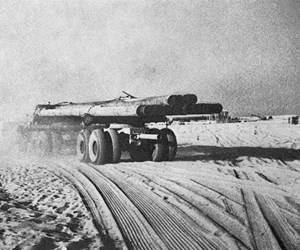Ghawar Field: Discovery of the industry’s oil mecca
Following the discovery of Abqaiq oil field in the Eastern Province of Saudi Arabia in 1940, a young geologist was mapping adjacent quadrangles near the edge of the Rub’ al-Khali desert.

The geologist, Ernie Berg, was specifically mapping a dry river bed known as the Wadi Sahaba, when he noticed that it took a sharp turn to the south, straying from its normal east-west course. There appeared to be no explanation for such a sudden shift in course. The bend then turned again to the east, and disappeared southwest of Qatar.
Berg discerned that the river bed was being diverted by a broad, low-relief dome, which was the surface expression of a much larger anticline.
Berg’s map indicated a structural uplift that was causing the bend in the Wadi Sahaba. Uplifts like these are a primary indicator that an oil reservoir could be present. Everyone would be unaware, however, of exactly how monumental the discovery truly was for another 12 years.
With the onset of World War II, wildcat drilling was suspended, due to the increased difficulty in acquiring the necessary supplies, as well as the loss of men to the war effort. A shallow-drilling campaign resumed, however. Designed to confirm geologic structures, the campaign successfully confirmed the existence of a subsurface anticline that extended northward.
When WWII ended, wildcat drilling resumed immediately. A test well, Ain Dar No. 1, was completed on July 22, 1948, resulting in the country’s first post-war oil discovery. It was a remarkable discovery for Aramco, producing 15,600 bopd after going onstream in early 1951.
Exploration of the area continued. In December 1948, World Oil reported, “Preparations are now underway to drill another wildcat more than 100 miles to the south, on the same continuous line of folding, and conceivably on the same structure.” The well, Haradh No. 1, was drilled successfully in 1949. It was the second of five discovery wells that made up Ghawar, the world’s largest oil field.
A connection between the wells was not made for another three years, after all five wells had been discovered. It was then that geologists recognized that they were dealing with one continuous reservoir, designated Ghawar field. The field proved to be the world’s largest, stretching 280 km in length, and approximately 40 km in width. It is estimated to account for about 6% of the world’s total daily crude output. Since its discovery, Aramco has produced more than 63 Bbbl from what is still considered the oil industry’s mega field, Ghawar. ![]()


